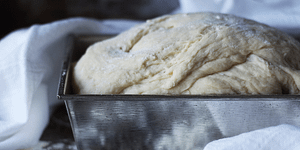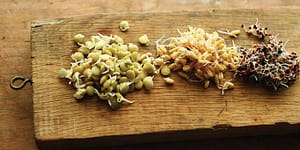Fermentation 101: Just Add Salt

Fermentation isn’t just for highly skilled experts, at its core, fermentation is actually pretty simple. Once you’ve mastered the basics of fermentation, you’ll be on your way to creating delicious and unique dishes in no time!
The following is an excerpt from Wildcrafted Fermentation by Pascal Baudar. It has been adapted for the web.
For readers who are new to fermentation, I thought it would be a good idea to explain in very simple ways how the process works. You can find much more information online or in such books as Wild Fermentation or The Art of Fermentation by Sandor Katz.
Here’s the simplicity of it: Go to the store and buy a peach, tomato, cucumber, cabbage, or cauliflower, then leave it on the table at room temperature for a few days or weeks. It will rot. This is due to the presence of countless microorganisms on the surface of fruits and vegetables that are competing with one another for survival.
While a lot of microorganisms can lead the food to rotting, some of them—the Lactobacillus bacteria—are beneficial and can help you preserve food. The challenge of lacto-fermentation is to find ways to promote the growth of beneficial bacteria and inhibit the ones that promote rotting.
The solution for that challenge is quite simple: Add salt.
For some magical reason salt inhibits the growth of the “bad” microbes prone to spoiling the food, while the “good” ones can tolerate it. By mixing salt with your vegetables/fruits or placing them in a brine, you’re promoting the growth of microbes that will help preserve your food while wiping out most of the bad ones. It’s already a tremendous advantage to start with.
A lot of the traditionally fermentable foods such as tomatoes, cabbages, peppers, and radishes contain a decent amount of sugar. That’s important, too, because lacto bacteria love sugar and the addition of salt also induces osmotic pressure, which helps facilitate the extraction of “sugary” juice from your foods. That’s the second advantage. You’ve already eliminated a lot of the bad guys by using salt, and because you use ingredients that contain sugar, you are now feeding the good ones.
The lacto bacteria eat the sugar present in the vegetables or fruits and convert it to lactic acid, which then acts as a preservative, further inhibiting the bad guys. That’s the third advantage. It’s also why vinegar works well as a preservation method, because microbes that can spoil food don’t like an acidic environment. In the process this acidic environment will give ferments their typical sour and tangy flavors.
The last and final advantage of this food preservation technique is the fact that bacteria prone to spoiling food don’t like an anaerobic environment, which is why fermentation is usually done within closed containers such as jars or crocks.
So lacto-fermentation really provides you with a lot of advantages in your quest to preserve food:
- Use of salt to inhibit the growth of bad guys.
- Use of sugary ingredients to feed the good bacteria (Lactobacillus).
- Production of an acidic environment by the conversion of sugar to lactic acid by lacto bacteria.
- Fermentation in closed containers, which also inhibits the bad bacteria from spoiling the food.
Of course, there are some exceptions or clever methods to work around the advantages used. For example, you don’t always need to add pure salt, and some people will ferment vegetables using celery juice (which contains sodium) or seaweed. But the basic principles behind fermentation will stay true.
At normal room temperature (70–75°F / 21–24°C), the fermenting ingredients will go through various stages. The first 10 days are usually the most active. From day 1 to day 3, you may notice some very light bubbling occurring; then there’s another 2-to-3-day period of very 
Fermentation is a process that was mostly used by people to preserve food during the cooler temperatures of winter, but you can do it at any time of the year. Leaving your ferment at room temperature for too long can alter the texture and taste—particularly for someone like me who lives in Southern California. The next step, after the initial fermentation, is to place your ferment in the fridge. Due to the low temperature, the fermentation process will continue, but extremely slowly.
How long can you keep your ferment in the fridge? For a very long time! It’s often based on your own preferences. The ferment continues to evolve over time. Fermented salsas are usually eaten within a week; after that they can become too mushy. I’ve eaten sauerkraut that had been stored in the fridge for a year and was still crunchy. Some people enjoy kimchi after several years.
My own personal preference is to try to eat ferments such as sauerkraut or kimchi within 2 to 5 months, but I don’t have any rules as to when you can start eating them. For example, I like to eat some of my fermented raw soups or salsas after 3 or 4 days of fermentation, and many of my lacto-fermented cheeses are at their best flavors within 10 days. Taste your ferments as you go along and you’ll learn how you like them, young or old.
Some people advocate that, for optimal health benefits, it’s best to eat ferments after a couple of months. They’re probably correct, but you can also ferment for flavors—and this book is mostly about flavors. The health benefits are a bonus.
Recommended Reads
Recent Articles
Have you heard of silvopasture? This system of managing grazing animals is an ancient practice that integrates trees and pasture into a single system for raising livestock. These systems are managed for both forest products and forage, providing short-and long-term income sources in a mutually beneficial way for healthier animals, better soil, less pest control and mowing, and…
Read MoreWant to spice up your traditional bread recipes? This salt-rising bread recipe by fermentation expert Sandor Ellix Katz has all the simplicity, flavor, and uniqueness you’ve been searching for! The following is an excerpt from Sandor Katz’s Fermentation Journeys by Sandor Ellix Katz. It has been adapted for the web. What Is Salt-Rising Bread? Salt-rising…
Read MoreNothing says “spring” like a fresh, foraged meal! Savor the flavors of the season with this Milkweed Bud Pizza recipe.
Read MoreOxeye daisies are one of the most important plants for pollinators including beetles, ants, and moths that use oxeye daisies as a source of pollen and nectar. Instead of thinking about removing a plant like oxeye daisy, consider how you can improve the fertility and diversity of habitat resources in your home landscape, garden, or…
Read More









